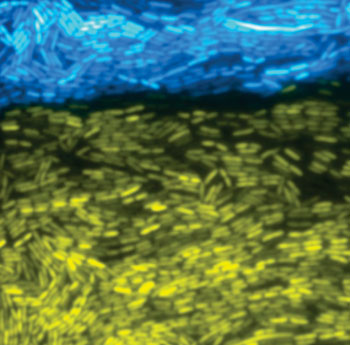Synthetic Biologists Create Interlinked Microbial Populations
By LabMedica International staff writers
Posted on 10 Sep 2015
A team of synthetic biologists has demonstrated a method for controlling how populations of microbial cells interact and regulate each other.Posted on 10 Sep 2015
A challenge of synthetic biology is the creation of cooperative microbial systems that exhibit population-level behaviors. Such systems use cellular signaling mechanisms to regulate gene expression across multiple cell types.

Image: Fluorescence micrograph of two strains of synthetically engineered bacteria cooperating to create multicellular phenomena. The biological circuit was created by programming bacteria to alter gene expression in an entire population (Photo courtesy of Bennett Lab/Rice University).
In an attempt to create such a system artificially, investigators at Rice University (Houston, TX, USA) constructed a synthetic microbial consortium from genetically engineered populations of E. coli that comprised two distinct cell types—an “activator” strain and a “repressor” strain. The activator strain upregulated the expression of targeted genes while the repressor strain downregulated the same genes. The bacteria, which were grown in microfluidic culture devices, had been engineered to synthesize fluorescent reporter genes so their activities could be monitored.
Results published in the August 28, 2015, issue of the journal Science revealed that the strains produced two orthogonal cell-signaling molecules that regulated gene expression within a synthetic circuit spanning both strains. Of particular interest was the observation that the two strains generated emergent, population-level oscillations only when cultured together.
"The main push in synthetic biology has been to engineer single cells," said senior author Dr. Matthew R. Bennett, assistant professor of biochemistry and cell biology at Rice University. "But now we are moving toward multicellular systems. We want cells to coordinate their behaviors in order to elicit a populational response, just the way our bodies do. We have many different types of cells in our bodies, from skin cells to liver cells to pancreatic cells, and they all coordinate their behaviors to make us work properly. To do this, they often send out small signaling molecules that are produced in one cell type and effect change in another cell type. We take that principle and engineer it into these very simple organisms to see if we can understand and build multicellular systems from the ground up."
Related Links:
Rice University













